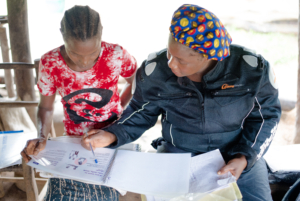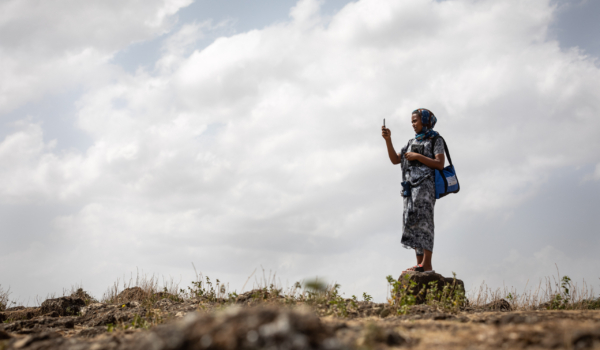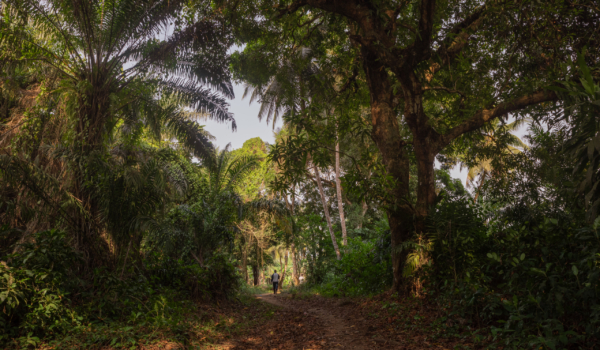Janjay Teedoe vividly remembers the day she learned about Liberia’s National Community Health Program. A mother of seven children—four still living—she supported her family with income from her small farm in remote Rivercess County, Liberia. She listened eagerly as she learned how she could supplement her earnings as a paid, professional community health worker—and at the same time, help provide needed care to mothers and children.
“The thing that really held my heart for me to do this work was that I wanted to cut down on child deaths, maternal deaths, and other deaths in the community,” Janjay says. “People used to die in childbirth because of home deliveries. And the small children, when they were sick in the night their mother could not take them and carry them to the clinic. Some of them would die.” As a community health worker, she could serve as a vital link to the health system in her town of Bonwein, a two-and-a-half hour walk from the nearest clinic.
With her heart set on earning money to support her children’s education while working to end needless deaths in her community, Janjay applied to become a community health worker (known in Liberia as a community health assistant). She completed her training in 2018 and began providing essential healthcare, addressing urgent maternal and child health needs by teaching women about safe pregnancy, delivery, and child health practices. She also delivers child health services with a focus on three major illnesses: diarrhea, pneumonia, and malaria.
Malaria, Janjay explains, has always been a serious danger for children in Rivercess County. “We really used to suffer,” she recalls. “Malaria is not a small sickness. It can kill people quickly.” Before she became a community health worker, accessing diagnosis and treatment for malaria required walking the long distance to the clinic in Timbo—an arduous journey to make with a sick child, and one that often prevented mothers from seeking help for malaria until symptoms were dire. “Sometimes children would die on the road,” she remembers. Medication, too, was inaccessible to many, carrying a high cost that few families could afford.
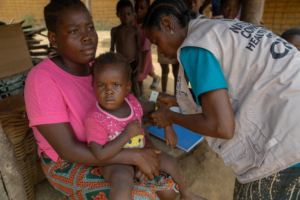
Janjay conducts a patient visit, screening a child for malnutrition using a middle-upper arm circumference tape.
As part of her community health worker training, Janjay learned how to lead malaria prevention efforts in Bonwein. “Now we are closing the windows when the sun sets and sleeping under good mosquito nets,” she says. Community members keep the grasses cut and clear reservoirs like buckets and old tires that can shelter mosquitoes. These preventive actions—all of which Janjay explains as part of her health education work—are crucial in helping reduce the prevalence of malaria in Bonwein.
When children do develop symptoms, Janjay is able to diagnose and treat them within the community. Parents know to bring their children to her if they show signs of illness, and when Janjay identifies symptoms of malaria—such as fever and vomiting—she performs a rapid diagnostic test. For children who test positive, she administers treatment at no cost, and for severe cases, she helps ensure families are able to reach the clinic where her supervisor, Theresa Mah, can provide a higher level of care. “Malaria is going down small-small,” she says with relief. “Our children aren’t dying like before.”
Despite the progress community health workers like Janjay have made possible, malaria remains a threat: it ranks as the leading cause of death among children under five in Liberia. But in 2024, Janjay learned about a new intervention: malaria vaccines would be rolled out across the country as part of the routine childhood immunization program, and community health workers would play a key role in helping ensure access for children under five. Rivercess was the first Liberian county to administer the vaccines, with health worker training led by the Ministry of Health and Last Mile Health with support from GSK.
Outreach led by community health workers is key to the Ministry’s malaria immunization strategy. Equipped with training on how the vaccines work and who should receive them, Janjay teaches her neighbors about their importance and keeps connected with her supervisor, tracking eligible children in her community and ensuring parents know when vaccinators will come to town. “If you are not able to walk down to the clinic, you can get vaccinated right here,” Janjay explains. “If you don’t have money to pay for transportation, you can get vaccinated right here. If you have to go work on the farm—as long as the farm is not too far—we will call for you and you can come and get vaccinated right here.”
Janjay has shared the knowledge she learned in her training: while no single intervention for malaria control is sufficient as a standalone, vaccines have the potential to reduce clinical malaria, severe malaria, and malaria-related deaths, and have even greater community-level impact when integrated with other preventive tools. And her outreach has been effective: “I encouraged my community people to carry their children for malaria vaccination, and every one of them went there,” she reports.
In her seven years as a community health worker, Janjay’s life has changed. With the income she receives for her work, she is able to pay her children’s school fees and has installed a new metal roof on her home. Her greatest source of pride, however, is the change she’s impacted on maternal and child health.
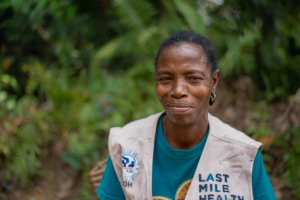
Janjay walks from home to home in Bonwein to provide health education and check up on her neighbors’ health.
“Before, pregnant women were more likely to die because they didn’t usually go to the clinic,” says Janjay. “Now, they’re going to the facility for their checkups.” Women are accessing family planning options, having healthier pregnancies and healthier children as a result. Immunization rates are up, and when children do get sick, parents no longer have to make impossible decisions about long journeys and expensive medicines: instead, they visit Janjay to receive the advice and care they need right at their doorsteps.
“Children are getting their vaccines now,” she says proudly. “Before we had nothing unless they go to the clinic but now, we don’t have to go anywhere else. We can treat our own children in our own community now, so things are better.”


